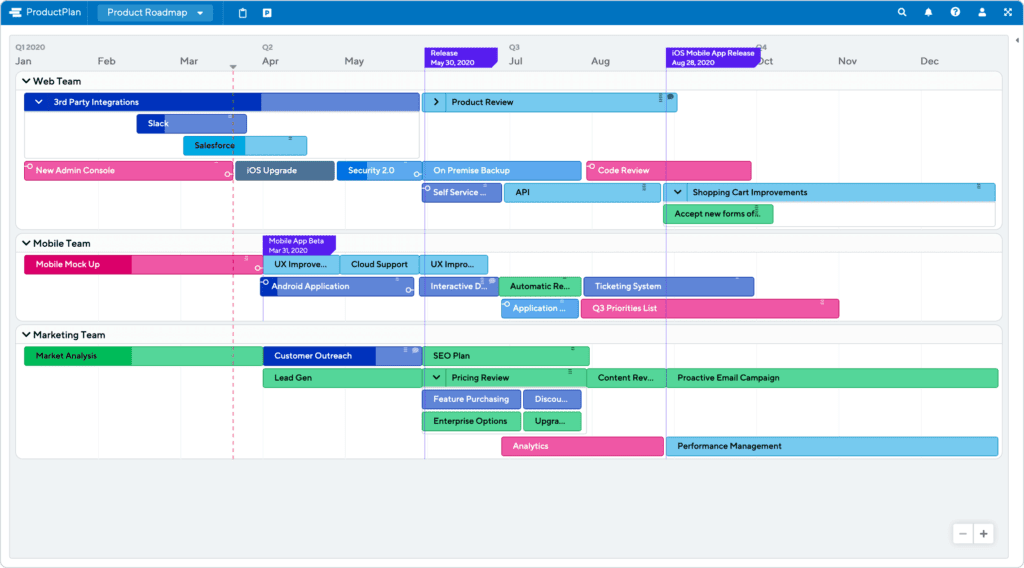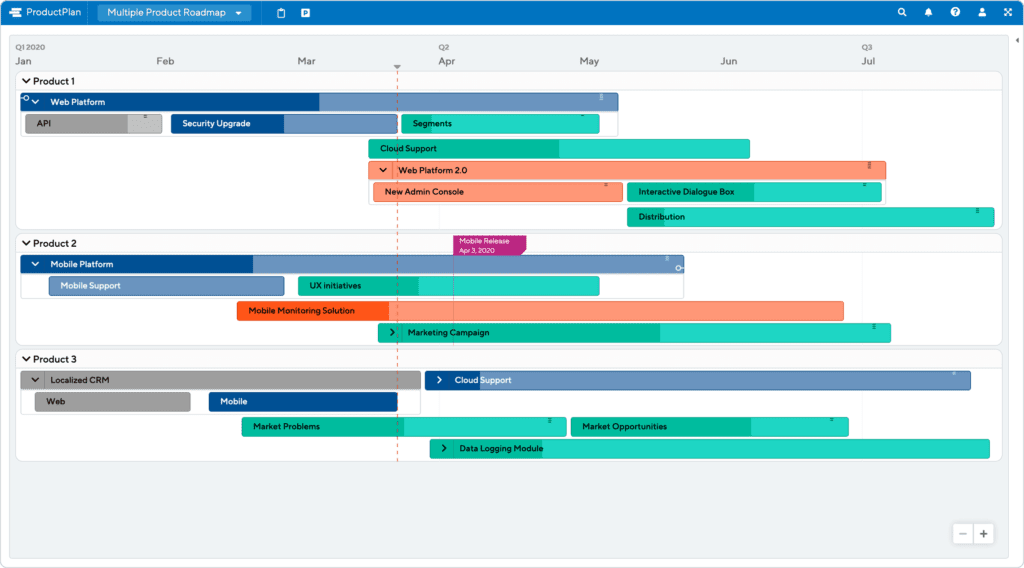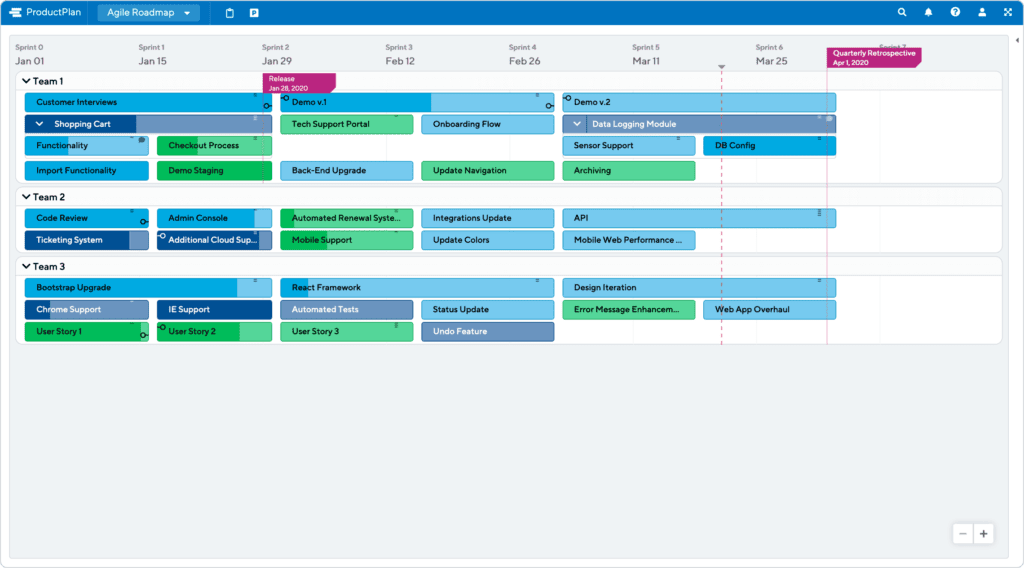A product roadmap is a high-level summary that maps out your product vision and overarching product strategy. A product roadmap communicates the why behind what you’re building. It’s a strategic document as well as a plan for executing your strategy.
It’s no secret that a good product roadmap can improve your team’s efficiency. But where do product managers start? Sometimes, it helps to see a well-crafted product roadmap example.
Example Roadmaps:
- Product Roadmap
- Multiple Product Roadmap
- Agile/Sprint Roadmap
There are countless ways to create a roadmap. The best strategy for creating your roadmap and format for communicating it will depend on your product and your organization. Some teams use roadmaps to plan releases, while others use roadmaps to manage entire product lines. The visual display of a roadmap is generally consistent, however. Here is a basic product roadmap example:
In this post, we discuss in more detail the following three variations of a product roadmap example:
A product roadmap should not solely be a presentation document. It is not meant to just be built after determining a product’s strategy. In fact, a product roadmap should supplement your in-person product strategy conversations — setting goals and planning strategic initiatives. It is a hands-on, living tool — where the product manager’s work of determining high-level planning should be reflected.
Many companies get this wrong. They treat this all-important strategic document, the product roadmap, as merely a presentation tool. As a result, the typical product manager is forced to use PowerPoint or similar applications to create and present to stakeholders a roadmap that is essentially a static image.
The Risks of a Static, Presentation-Only Roadmap
Why is this a mistake?
Because at any given moment, a product roadmap should reflect the latest strategic thinking, planning and needed resources, based on the most current information available, for the product — and information and priorities can change often. With a static roadmap, every day the product’s development progresses the roadmap grows more outdated and less useful.
To be successful, a product manager needs a living, up-to-date product roadmap — both to help all relevant constituencies (and the product manager herself) step back and understand where the product’s development stands, and to be able to adjust effectively and intelligently when circumstances necessitate a shift in strategy.
In other words, as a product manager, you should not just update your roadmap before a development meeting or executive stakeholder presentation. You should essentially be living in that document all the time — reviewing it, updating it, re-examining its goals and deadlines in light of new realities in your company and in the market. Bottom line: You should be spending a good portion of your day in your product roadmap so that the roadmap won’t fail.
And because different development scenarios will benefit from different types of roadmaps, here is an overview of three product roadmap templates.

Single Product Roadmap Example

If you are responsible for one product, then your roadmap might look similar to the single product roadmap example above.
This is a strategic, high-level document — you will not simply build it to show your executives, earn their buy-in, and then shelve it while you get on with the real work of driving the product’s development.
This product roadmap will be one of your primary, ongoing tools for driving that development. It should be informed of what you are doing virtually every day.
For example, let’s say your single product roadmap covers a six-month development time horizon. If you have built into this document a planned October release for an add-on to your product’s mobile app, then you will know in February or March that it is time to start thinking about what levels of spend and resources you will need for development, what types of testing you will need to do, what documentation and collateral will need to be created, etc. And with that foresight, you can start planning now to get those initiatives underway so they are ready in time for the add-on’s release.
In other words, your standard product roadmap should give you both a longer-term view of your product’s plans and a more ground-level guide as to what you should be focusing on to meet those goals and deadlines.
Multiple Product Roadmap Example

If you manage more than one product, you may be maintaining a multiple product roadmap.
A roadmap that combines several products has the added benefit of allowing you to create a long-term strategic view of your product’s journey in the larger context of the simultaneous development of your other products.
You could maintain several single-product roadmaps, one for each product you are responsible for. But this would create duplicate work, force you to track and review more documents and deprive you and your constituents of the ability to view each product in the context of other initiatives.
Agile/Sprint Roadmap Example

Whereas your single- and multiple-product roadmaps often times are focused on communicating your strategy to executive stakeholders, you will use your agile/sprint roadmap primarily with your development team.
Although it is focused primarily on short-term details, the agile/sprint roadmap should still present a strategic view — linking together the disparate features and stories in a sprint to show how each of these individual projects are working toward a unifying objective. This is important because your developers need to understand the product’s overall strategic direction.
An agile/sprint roadmap can prove invaluable when it comes to releasing planning. Because these are shorter-term, task-oriented roadmaps, they are a great way of setting — and then keeping a close and constant eye on — a product’s planned release dates.
If you set a product release a few months out, for example, you can then use your agile/sprint roadmap to prioritize the essential initiatives you need to be completed before that go-to-market date. This can help immensely with team focus and prevent teams or individuals from becoming distracted with lower-priority tasks.
A Product Roadmap is a Hands-on Strategic Tool — not a Static Document — and Choosing the Right Roadmap Matters
Contrary to the practices of many organizations, product roadmaps are not meant to be one-time, static documents to present a product’s plan and then set aside when the work begins.
Product roadmaps should be a significant part of a product manager’s day-to-day work. If created and maintained correctly, a roadmap can help product teams step back anytime and examine their strategic objectives. At the same time, it can provide a clear framework to plan, track and manage the detailed assignments needed to meet those strategic objectives.
This is why product roadmaps should not be built-in presentation tools: Such one-off documents have to be continually, manually updated — or else they will become increasingly worthless with time.
And because they can be such an integral part of a product manager’s daily workflow, it is worth spending the time to determine which product roadmap style is right for a given initiative. Check out our Resources section to see more product roadmap templates and other useful product management tips.




